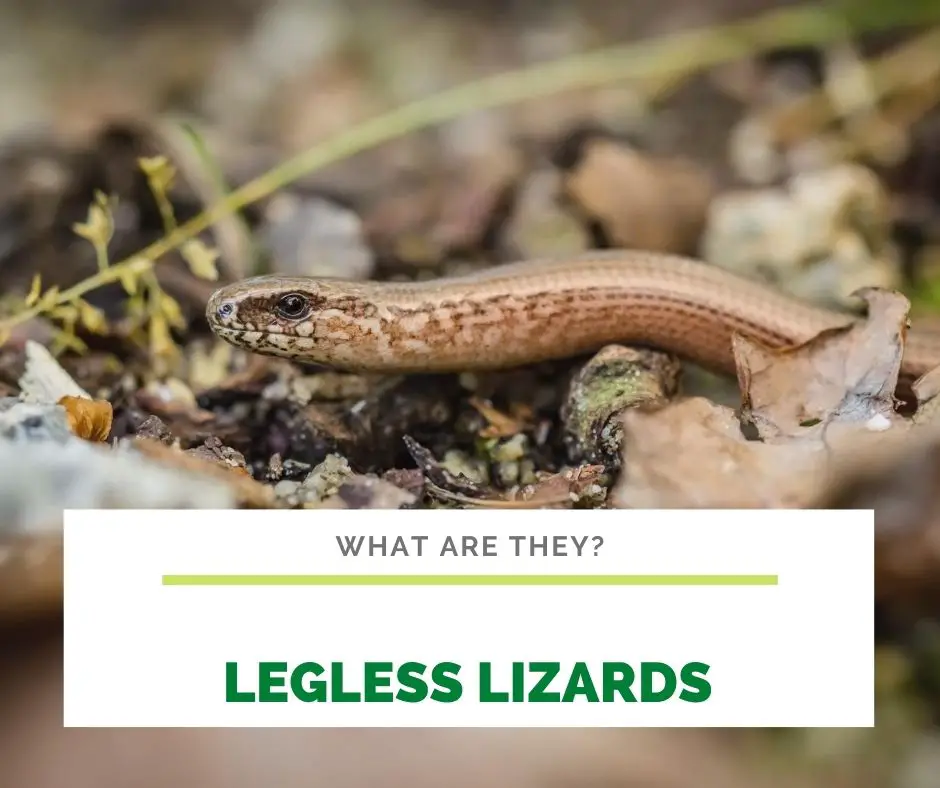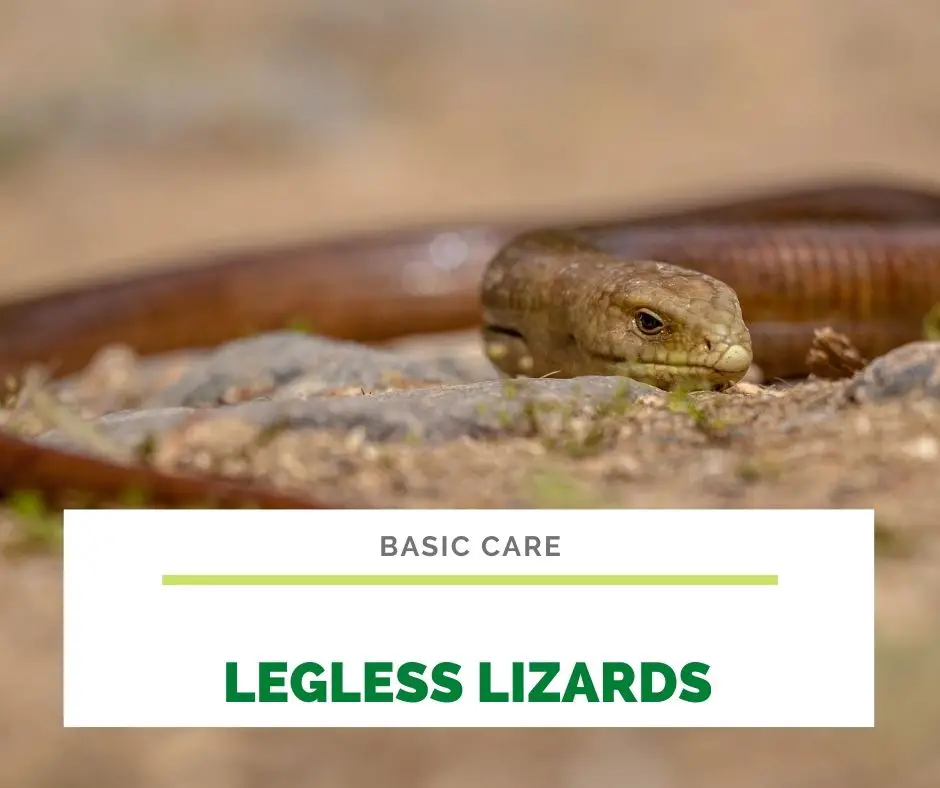Lizard that looks like a snake with legs is a legless lizard. They can also refer to any of several groups of lizards that have independently lost limbs or reduced them to the factor of being of no use in locomotion
Contents
What are Legless Lizards?

Lizards are some of the most popular pets in the world. There are several varieties of pet lizards.
Among them are the legless lizards, which resemble snakes to a large extent. There are different species of legless lizards that pet keepers can select from.
Legless lizards are lizards that have undergone evolution to a stage where their limbs do not function.
They belong to the family Pygopodidae. Despite their limbs being functionless they normally have some free-floating leftovers of a hipbone and small tips of rear legs.
Whereas these lizards have similar appearance to a snake, a closer look will show several distinguishing features. For instance, their ears open externally, they lack broad belly scales, they may or may not have long, and they have eyelids.
There are several legless lizard pets and the following table outlines their adult size, food and care level.
The full list of legless lizards
| Name | Size | Food | Care Level |
| Burton’s Legless Lizard | Up to 2.5ft | Lizards, small snakes, | Advanced |
| Slow-worm lizard | 1.3ft – 1.6ft | Slugs, snails, worms, insects, caterpillars | Advanced |
| California Legless Lizard | 0.3ft – 0.5ft | Insect larvae, termites, small adult insects, beetles and spiders | Advanced |
| Eastern Glass Lizard | 1.5ft – 3.6ft | insects, spiders, other invertebrates, rodents | Intermediate |
| Island Glass Lizard | 1.25ft – 5.1ft | Insects, spiders, invertebrates, rodents | Advanced |
| Mimic Glass Lizard | 1.25ft – 2.2ft | Insects, spiders, invertebrates, rodents | Advanced |
| Slender Glass Lizard | 1.8ft – 3.5ft | Insects, spiders, invertebrates, rodents | Intermediate |
| Striped Legless Lizard | 1.1ft – 1.3ft | spiders, crickets, moth larvae cockroaches and grasshoppers | Advanced |
| Olive Legless Lizard | Up to 1.1ft | Insects, spiders | Advanced |
| Pink-tailed Worm- lizard | Up to 1ft | Insects, spiders, invertebrates | Advanced |
| Common Scaly Foot | Up to 1.6ft | Insects, spiders, invertebrates | Advanced |
| Hooded Scaly Foot | Up to 1.3ft | Spiders, spider egg sacks, scorpions | Beginner |
| Sheltopusik Legless Lizard | 2ft – 3ft | Live bugs, Canned insects, Pinky mice, fruits | Advanced |
| European Legless Lizard | 3ft – 4ft | live insects including crickets,mealworms, waxworms, cockroach nymphs, and small rodents | Advanced |
Legless Lizards as Pets

Enclosure For A Legless Lizard
For most legless lizards, a 20-gallon long aquarium should be the minimum recommended size.
However, one should always consider going larger. It needs to have hiding places around the enclosure, and rocks or branches to offer climbing areas.
It is important to consider different needs of the specific species of the legless lizard as some may have unique needs.
Temperature For A Legless Lizard
Similar to other reptiles, legless lizards depend on thermoregulation to control their body temperatures.
Therefore, it is required that the enclosure has a cool and warm side.
Place all heating elements on one side and leave the other one as the cooler zone.
The legless lizards can move back and forth the two zones as they need.
It is vital to maintain daytime temperatures between 70o and 85o F.
During night time, temperatures can be dropped by 10o F compared to daytime temperature.
Make use of high-quality temperature gauges like the Zoo Med digital temperature gauge, or the one provided by Exo Terras.
A heating pad or a basking bulb can be used in the heating of the enclosure.
In addition to the heat, UVB lighting is necessary to assist the lizards absorb calcium and synthesize vitamin D3.
Since these lizards are not outside getting natural sunlight, they need UVB lighting in the form of a fluorescent light that produces UVB rays.
When purchasing the bulb, some recommended manufacturers include Exo Terra, ZooMed and Solar Bright.
Humidity For A Legless Lizard
When it comes to humidity, it is reliant on the species of the lizard.
However, even those that reside in dry areas need some moisture.
Light spraying in their enclosure with water in the morning is essential.
It will dampen the top later of the substrate and remain wet for about an hour.
Ensure that it does not become excessively damp. Using hand misters is sufficient for the task.
Additionally, place a bowl of fresh water in the enclosure for the lizard.
In case the lizard defecates in the water, you need to change it.
Wash and scrub the dish at least once a week to prevent bacteria slime from building up.
Feeding For A Legless Lizard
Most adults fed twice or thrice a week.
Younger lizards feed every other day. It is important to research the specific feeding habits of your species of lizard.
When you feed them, they can eat as much as they want in a single sitting. Instead of placing food directly on to the substrate, place it on a shallow dish.
It is important to supplement the feed with calcium and vitamins every other feeding. There is a wide variety of food that legless lizard can take, and some suggestions include:
- Live bugs
- Canned insects
- Shrimp,
- Scrambled or boiled eggs
- Snails
- Fruits
- Pinky mice
- Collard greens
- Carrots
- Papaya
- Raspberries etc.
Ensure that the food is right for your pet legless lizard species.
Temperament For A Legless Lizard
Legless lizards do not care to be handled often. In case they get stressed, their tails can shed, although it is rare. If you keep feeding them, they become quite responsive to you and tame enough to allow gentle handling.
Furthermore, legless lizards are hardy species, which are enjoyable to observe and keep as pets.
Best Legless Lizards for Beginners
While legless lizards fall under the categories of good pets to keep, they tend to be slightly tough for beginners.
Most of them are ideal for intermediate and advanced keepers.
Nonetheless, you can get a Hooded Scaly Foot legless lizard, which is ideal for a beginner.
Hooded Scaly Foot is endemic in Australia. It comes in different species include western, black-headed, and eastern hooded scaly foot.
They commonly fed on surface-active arthropods and easily be tamed. One big plus thing is they do not require an advanced skill when keeping them.
Nonetheless, it remains important to get extensive understanding of their needs.
Wrapping Up
Legless lizards are intelligent and easy to care for.
They do not grow to huge sizes hence easy to manage.
They are intelligent animals with a good appetite.
Depending on the species, handling is possible and makes robust captives.
They are also immune to most common diseases that affect reptiles.